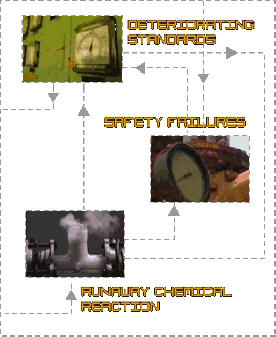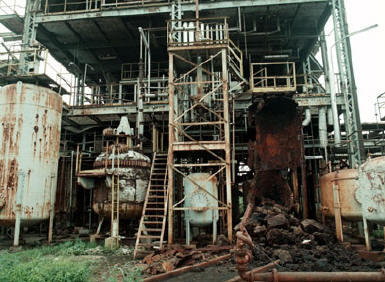|
Welcome
Site index
A to Z listing
Advertising
Books
Corrosion glossary
Disclaimer
Famous scientists
Corrosion course
Distance Ed
Doomsday scenarios
Links
Modules
Monitoring glossary
Photo gallery
Rare earths
Search this site
Textbook assignments
Toxic elements
Water glossary
Webmaster
| |
Bhopal Accident
Bhopal is probably the site of the greatest
industrial disaster in history.
Between 1977 and 1984, Union Carbide India Limited (UCIL),
located within a crowded working class neighborhood in Bhopal, was licensed by
the Madhya Pradesh Government to manufacture phosgene, monomethylamine (MMA),
methylisocyanate (MIC) and the pesticide carbaryl, also known as Sevin.
| On the night of the 2-3 December 1984 water inadvertently
entered the MIC storage tank, where over 40 metric tons of MIC were being
stored. The addition of water to the tank caused a runaway chemical
reaction, resulting in a rapid rise in pressure and temperature. The heat
generated by the reaction, the presence of higher than normal concentrations
of chloroform, and the presence of an iron catalyst , produced by the corrosion of the stainless steel tank
wall,
resulted in a reaction of such momentum, that gases formed could not be
contained by safety systems. As a result, MIC and other reaction products, in
liquid and vapor form, escaped from the plant into the surrounding areas.
There was no warning for people surrounding the plant as the emergency
sirens had been switched off. The effect on the people living in the shanty
settlements just over the fence was immediate and devastating. Many died in
their beds, others staggered from their homes, blinded and choking, to die
in the street. |
 (graphic
courtesy) |
Many more died later after reaching hospitals and emergency aid
centers. The early acute effects were vomiting and burning sensations in the
eyes, nose and throat, and most deaths have been attributed to respiratory
failure. For some, the toxic gas caused such massive internal secretions that
their lungs became clogged with fluids, while for others, spasmodic constriction
of the bronchial tubes led to suffocation. It is been estimated that at least
3000 people died as a result of this accident, while figures for the number of
people injured currently range from 200,000 to 600,000, with an estimated
500,000 typically quoted. The factory was closed down after the accident.
|
 |
The Bhopal disaster was the result of a
combination of legal, technological, organizational, and human
errors. The immediate cause of the chemical reaction was the seepage
of water (500 liters) into the MIC storage tank. The results of this
reaction were exacerbated by the failure of containment and safety
measures and by a complete absence of community information and
emergency procedures. (photo
courtesy) |
The long term effects were made worse by the absence of systems
to care for and compensate the victims. Furthermore, safety standards and
maintenance procedures at the plant had been deteriorating and ignored for
months. A listing of the defects of the
MIC unit runs as follows(reference):
-
Gauges measuring temperature and pressure in the
various parts of the unit, including the crucial MIC storage tanks,
were so notoriously unreliable that workers ignored early signs of
trouble.
-
The refrigeration unit for keeping MIC at low
temperatures (and therefore less likely to undergo overheating and
expansion should a contaminant enter the tank) had been shut off for
some time.
-
The gas scrubber, designed to neutralize any escaping
MIC, had been shut off for maintenance. Even had it been operative,
post-disaster inquiries revealed, the maximum pressure it could handle
was only one-quarter that which was actually reached in the accident.
-
The flare tower, designed to burn off MIC escaping
from the scrubber, was also turned off, waiting for replacement of a
corroded piece of pipe. The tower, however, was inadequately designed
for its task, as it was capable of handling only a quarter of the
volume of gas released.
-
The water curtain, designed to neutralize any
remaining gas, was too short to reach the top of the flare tower, from
where the MIC was billowing
-
The lack of effective warning systems; the alarm on
the storage tank failed to signal the increase in temperature on the
night of the disaster
-
MIC storage tank number 610 was filled beyond
recommended capacity; and -a storage tank which was supposed to be
held in reserve for excess MIC already contained the MIC.

Other corrosion accidents:
Aloha,
Bhopal,
Carlsbad,
Davis-Besse,
Guadalajara, EL AL,
Erika,
F-16,
FAC,
Flixborough,
Gaylord Chemical,
Oil pipeline
releases, Pitting of aircraft and helicopters,
Prudhoe Bay,
Silver bridge,
Swimming
Pool
|

